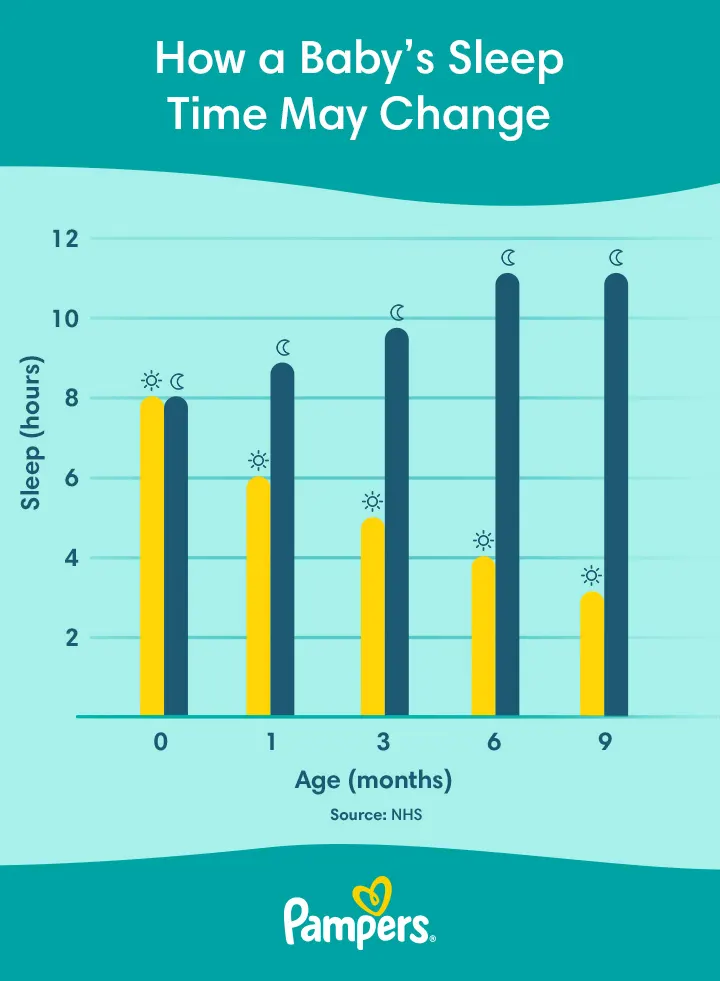
How Much Do Newborns Sleep?
Newborns tend to sleep frequently during both daytime and nighttime, but only for brief periods. As a parent, it can be exhausting to wake up throughout the night to comfort or feed your baby. To effectively manage the newborn stage, it is important to have an understanding of their sleep patterns.
If you have a little newborn in your life, it’s natural to wonder how long a newborn should sleep, when will any newborn sleep patterns start to emerge, and how to establish a sleep routine so that your baby gets the most out of their sleep. Keep reading for more.
How Much Sleep Do Newborns Need?
Every baby and child is different, and how much a newborn ‘should’ sleep may vary. But if you’re wondering ‘How many hours a day do newborns sleep?’ in general, newborns sleep from 8 to 18 hours in 24 hours, but the sleep doesn’t happen all at once. Instead, very young babies generally snooze in one- to three-hour blocks during both the day and night. This is usually because they need to eat every two to three hours. All of this sleep is essential for your baby’s healthy and happy development. Over time, this haphazard around-the-clock dozing will become more organised, with more of your little one's sleep hours taking place at night.
What Are a Newborn’s Sleep Patterns?
Unlike adults, who typically sleep for about seven hours at night and are awake for the rest of the day, newborn sleep patterns are quite different as they sleep in shorter blocks throughout both the day and night. To provide you with a general understanding, during the initial weeks, your newborn might sleep for approximately one to three hours, succeeded by a brief spell of wakefulness before slumbering once more. As time progresses, these periods of sleep may extend, eventually reaching around four or five hours in duration. By about 6 months of age, your baby’s newborn sleep patterns may begin to resemble those of an adult, meaning they might sleep for extended periods at night and be more alert during the day. Some babies might sleep for up to 12 hours at night. It’s important to remember that these prolonged periods of nighttime sleep might only last for about five or six hours. Although your 6-month-old may also be more active during the day, they will likely still need two or three daytime naps. It’s important to remember that every baby is unique and that your newborn’s sleep patterns may differ from what we’ve described here. The way sleep evolves from the around-the-clock blocks of a newborn to the longer nighttime sleep of an older child or adult is not a linear process. You may find that your older baby sleeps for longer periods for a few months, but then reverts to waking up more frequently in the middle of the night. This is commonly referred to as sleep regression and is a normal part of development. Sleep regression may occur when your child is feeling sick or unsettled, or when they’re going through a growth spurt or a developmental jump that affects their sleep pattern for a time. That’s not all: Even once your child is sleeping through the night, at least one daytime nap may still be needed for many years to come.
Stages of Sleep in Newborns
The sleep of newborns occurs in four stages: Stage 1: Drowsiness. Your baby becomes drowsy after a period of wakefulness and is ready to fall asleep. It’s a good idea to put your baby to sleep in their crib when they’re drowsy and not yet asleep. This can help establish a sleep routine for your newborn. Stage 2: REM (Rapid Eye Movement) or active sleep. Your baby may start to twitch or jerk their arms and legs, their eyelids may flutter, their breathing may be irregular and they may grunt or cry in their sleep. Then their breathing will return to a regular pace, with the cycle repeating. Newborns spend half their sleep in this REM stage. Stage 3: Light sleep. In this stage, your baby’s breathing is regular and sleep is not as active as in the previous stage. Stage 4 and 5: Deep or non-REM sleep. Also known as quiet sleep, this is the stage your baby falls into a deep sleep. There is no twitching or any other movements. It may be difficult to wake your baby in this stage should you need to for any reason.
When to Set Up a Sleep Routine for Your Newborn
It’s never too early to consider establishing a newborn sleep routine, but bear in mind that it may take several months before your baby develops a predictable sleep pattern. It’s generally recommended to wait until your little one is around 3 months old before starting a bedtime routine. Newborns don’t yet know the difference between day and night and their circadian rhythms are still developing. And because their stomachs are so small, newborns can only go for a few hours before they need to be fed again, even during the night. At this early stage, it’s more important to cater to your newborn’s feeding and sleeping needs (and biological clock), rather than pushing a strict sleep schedule onto your little one. Look out for your baby’s drowsy periods and sleep cues, and encourage (and allow) your little one to sleep then. If you desire, you can monitor the times your newborn slumbers and feeds, to help you formulate a bedtime routine that you could adhere to with regularity. Subsequently, as your baby grows, you might consider incorporating sleep training. Having a bedtime routine already in place may help this process.
How to Set Up a Bedtime Routine
The concept of a sleep routine for a newborn is designed to soothe and calm your baby prior to laying them down in their cot for rest, including both nighttime slumber and daytime naps. Because babies tend to love routine, having a simple ritual that you always follow helps your baby anticipate and learn that the time for sleep is coming, and helps them wind down. A bedtime sleep routine for your newborn or older baby might include a bath, a song or story, skin-to-skin contact or a baby massage. Avoid any stimulating activities in the period just before sleep. Ensure your baby is awake (yet sleepy) when you settle them into their cot. This aids in forming a positive sleep association with their cot and sleep environment.
When Do Newborns Sleep Through the Night?
Newborns can’t sleep through the night just yet. They need to be fed every few hours, and typically for short blocks of time. When your baby is 3 months or older, they may start to sleep through the night or for longer nighttime periods. Typically, a newborn might be deemed a ‘good sleeper’ if they can self-soothe and return to sleep on their own after waking up in the night; if they calm down swiftly following a feed or nappy change; or if a brief comforting gesture from a parent is sufficient for them to drift off again. Some babies can self-soothe instinctively whereas others will need a little help to learn how. Remember, for a newborn, being a ‘good sleeper’ doesn't mean not waking up; rather it means being able to return to sleep after a period of wakefulness. Understand that it may take a while for your baby to learn how to self-soothe, and even after they master it, there might be various fluctuations through babyhood, toddlerhood and beyond.
How to Get Your Newborn to Sleep at Night
All babies cry, and all parents experience a crying baby at night from time to time. There are many reasons your newborn may cry at night, rather than falling or staying asleep. For example, they may be uncomfortable, overstimulated or may need a nappy change. Here are some of the things you can try to help your baby settle and fall asleep:
Above all, try not to become stressed if your little one can’t seem to sleep; never act on any frustration you may be feeling by shaking or hitting your baby. Instead, leave your baby safely in their cot for a few minutes while you regroup in another room, and go back in when you feel calm and ready.
How Long Do Newborns Sleep at Night?
On average, newborns will sleep for around 8 to 18 hours in a 24-hour period, but in 1- to 3-hour stretches. This means your baby will sleep for several short blocks at night, which may total up to about eight hours. Remember, since every baby is different, your baby may sleep more or sleep less at night than this. As a general guide, here’s how much of your newborn’s total sleep occurs during daytime and nighttime, and how those hours shift month by month.
Can Newborns Sleep Too Much?
Many parents wonder whether their baby is sleeping too little or too much. This is an understandable concern, as you want your baby to be sleeping just the right amount. In your newborn’s first weeks, they’ll need to be fed about every three to four hours. If your newborn sleeps longer than four hours, you may need to wake them up for a feeding. Check in with your baby's GP or health visitor on this matter. Depending on your baby's weight, age and general state of health, they may recommend waking them up or letting them sleep. If your baby's afternoon naps are longer than three or four hours, it’s a good idea to wake them up for a feeding and some playtime. Naps that are too long or too close to bedtime can make falling asleep in the evening harder.
A Note on Newborn Baby Sleep Safety
A safe sleep environment is very important. Here are some important sleep safety recommendations to follow:
The Bottom Line
Newborns sleep a lot, and the fact that they doze only in short bursts around the clock can make this period a tiring one for you. Hang in there and try to get some rest whenever you can. Consider sharing middle-of-the-night feedings and nappy changes with your partner, and accept help from close friends and family so that you can have some time to relax. Try to remember that this exhausting newborn period will likely pass; eventually, your baby will sleep for longer and have more predictable sleep patterns. In time, the sleep-deprived fog of this newborn phase will pass, and you may even look back fondly on this bleary-eyed period.
How We Wrote This Article The information in this article is based on expert advice found in trusted medical and government sources, such as the National Health Service (NHS). You can find a full list of sources used for this article below. The content on this page should not replace professional medical advice. Always consult medical professionals for full diagnosis and treatment.
- Lullaby Trust. Safer Sleep Advice
- NCT. Newborns and Sleep: Routines and Patterns From 0-3 Months
- NHS. Helping Your Baby to Sleep
- NHS. Night Feeds
- NHS. Oral Health (0 – 5 Years)
- NHS. Safe Sleep
- NHS. Sleep (Infants 0-12 Months)
- NHS. Your Baby’s Sleep at 3-6 Months
- NHS. Your Baby’s Sleep Patterns
- Tommy’s Your Baby’s Sleep Patterns






